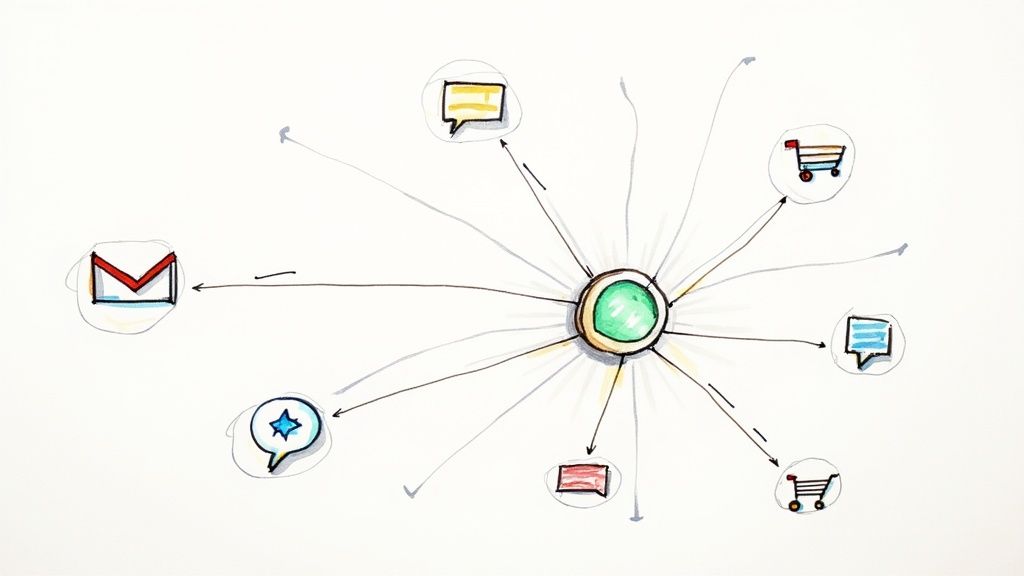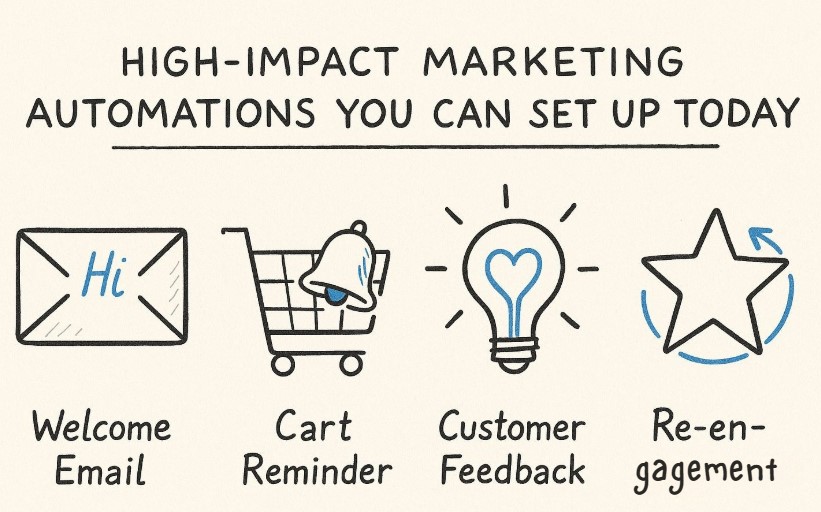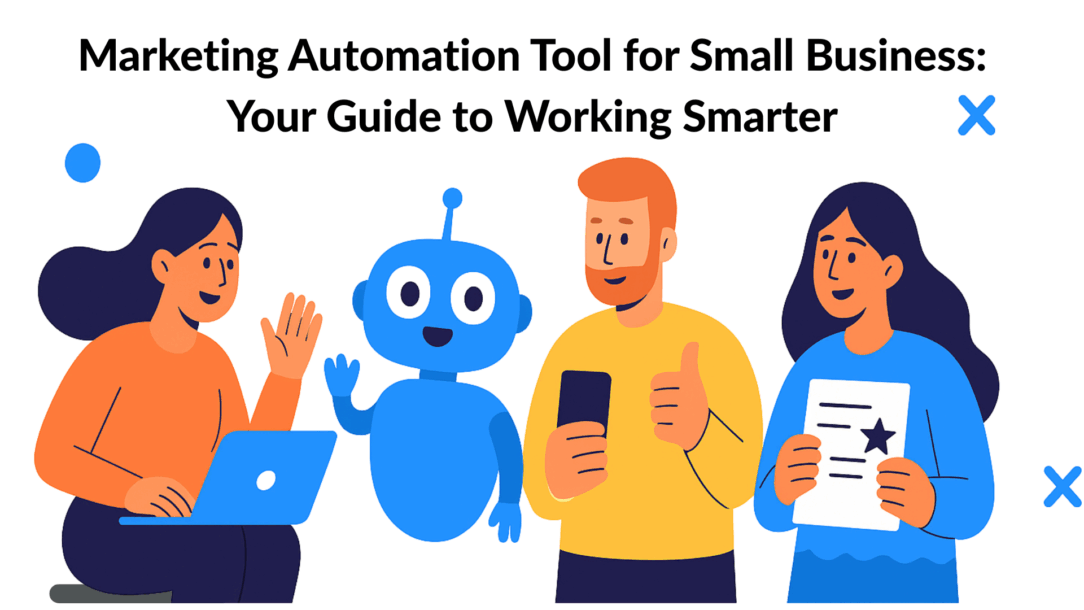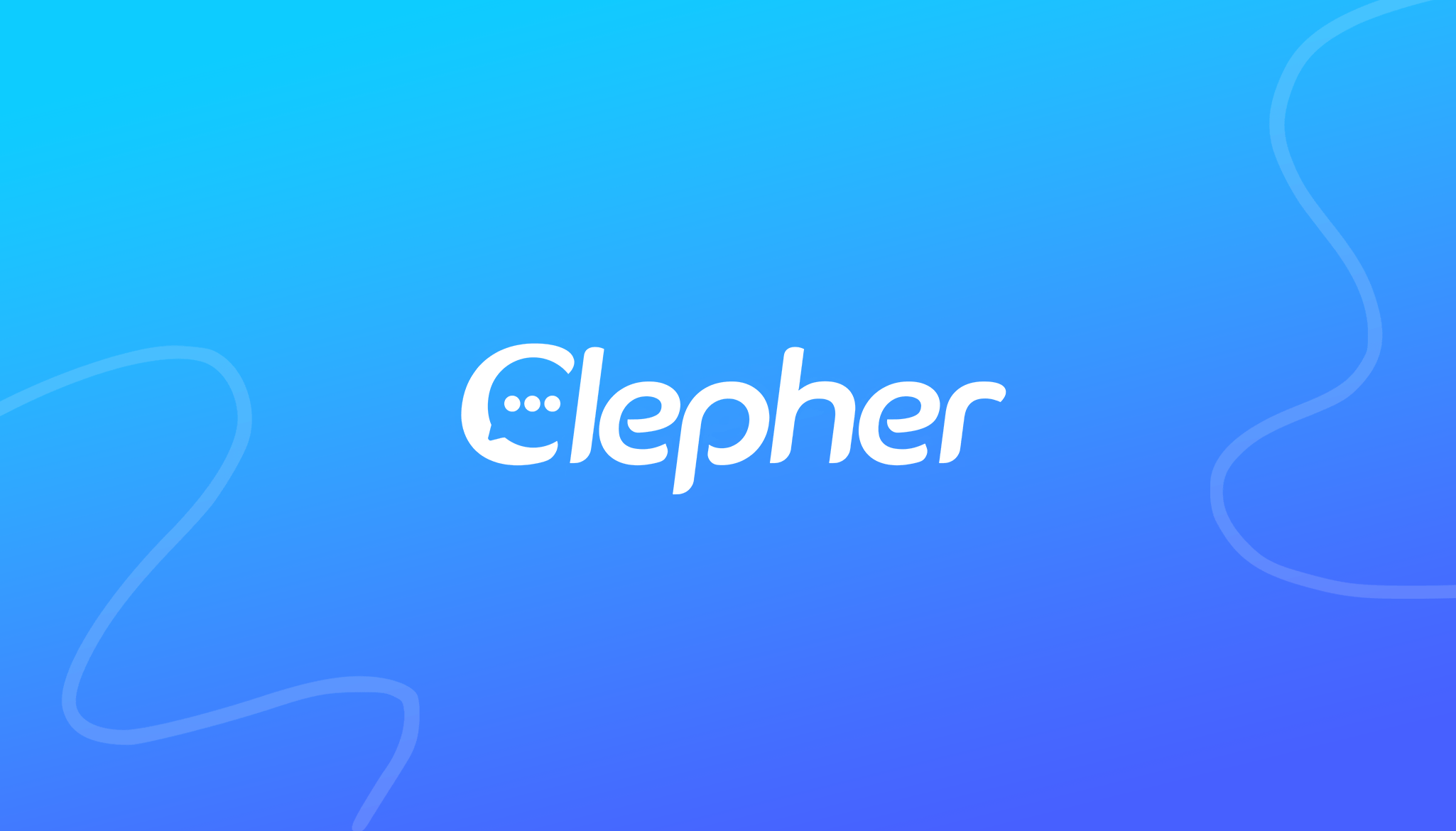For a small business owner, marketing automation is like finally getting that extra pair of hands you’ve been dreaming of. Think of it as a tireless digital assistant who works around the clock to nurture leads, chat with customers, and line up sales—all while you focus on the bigger picture.
It’s a system designed to take repetitive marketing chores off your plate. We’re talking about tasks like sending welcome emails, posting on social media, or following up with someone who visited your pricing page. You get to step away from the keyboard and back into building relationships and growing your business.
Putting Your Marketing on Autopilot

marketing automation on autopilot
If you’re running a small business, you know the to-do list never ends. You’re the CEO, head of marketing, lead salesperson, and the entire customer service department. Trying to manually send every email, track every lead, and schedule every social post isn’t just exhausting—it’s what holds you back from real growth.
This is where marketing automation for small businesses comes in and completely changes the game. With the right marketing automation software or small business marketing software, you can manage repetitive marketing tasks automatically and deliver a consistent experience for every customer—without burning out your team.
Let’s see how this works in the real world. A new visitor signs up for your newsletter. Instantly, your email marketing software sends them a personalized welcome message. A week later, it follows up with a genuinely helpful blog post. If they click a link about a specific product, the marketing automation platform notes their interest and, down the line, sends a perfectly timed offer. You only set up these “rules” once, and the technology handles the rest, flawlessly, for every single person.
The Real-World Impact on Your Business
This isn’t about becoming a robot or losing that personal connection—it’s actually the opposite. Automation frees you from tedious, time-sucking tasks so you can have more meaningful, high-value conversations with people who are genuinely interested in what you offer.
It’s your safety net, ensuring no lead ever slips through the cracks and every new customer feels acknowledged from the moment they find you.
By automating routine marketing activities using the best marketing automation tools, you create consistent, personalized experiences at a scale that was once only possible for large corporations. It levels the playing field, allowing you to compete more effectively.
For time-strapped entrepreneurs, the benefits are immediate and tangible. Let’s break down the most significant advantages you can expect.
Key Benefits of Automation at a Glance
| Benefit | Impact on Your Small Business |
|---|---|
| Time Savings | Reclaim hours every week by automating repetitive tasks like email follow-ups and social media posting. |
| Increased Revenue | Nurture leads 24/7, moving them closer to a sale without manual intervention. |
| Better Lead Quality | Automatically score and qualify leads, so you only spend time on the most promising prospects. |
| Improved Customer Retention | Keep customers engaged with personalized communication, boosting loyalty and repeat business. |
| Scalable Marketing | Grow your marketing efforts without having to grow your headcount. |
| Data-Driven Decisions | Gain clear insights into what’s working, allowing you to refine your strategy on the fly. |
Ultimately, these benefits lead to a stronger, more efficient business that can grow without burning you out.
This shift is much more than a trend. The marketing automation industry is exploding, with revenues expected to soar past $15 billion by 2030. And for small businesses, the proof is in the numbers: every dollar put into automation brings back an average return of $5.44. That’s efficiency you can take to the bank. To really get ahead, understanding how intelligent systems can supercharge your efforts is key. By exploring AI marketing automation, you’ll discover new ways to work smarter, not just harder.
What Marketing Automation Actually Does

what marketing automation does
Let’s cut through the buzzwords. At its heart, marketing automation is the engine that sends the perfect message to the right person at the exact right moment, all based on rules you set up beforehand.
It’s not about spamming your entire contact list with the same generic newsletter. Far from it. It’s about creating thoughtful, personalized customer journeys that build real relationships and guide people naturally toward becoming happy customers.
From Manual Grind to Smart Workflows
Think about marketing without automation—it’s a constant juggle of sending follow-up emails, tracking who’s interested in what, and watching good leads go cold simply because you got busy. Marketing automation for small business changes all that by letting you build simple “if this, then that” workflows that run 24/7 through an intuitive email marketing tool.
Here’s a practical example: someone visits your website and downloads your free guide to home gardening.
- The Trigger: They fill out the form and hit “submit.”
- The Action: The system instantly sends a thank-you email with a link to the guide—no waiting.
- The Follow-Up: A few days later, an automated email goes out with a helpful article, “3 Common Gardening Mistakes to Avoid.”
- The Next Step: A week later, another email shares a story about how your product helped someone grow a prize-winning tomato patch.
See what happened? You just created a helpful, relevant experience for that new lead without lifting a finger after setup. The system nurtures that relationship automatically, letting you scale that personal touch to hundreds—or even thousands—of people.
The real magic of a strong marketing automation platform is that it listens for customer actions and responds with the most relevant communication possible. It’s the difference between shouting with a megaphone and having a meaningful one-on-one conversation.
This is a game-changer for small businesses, where time and manpower are always in short supply. You get to stop drowning in repetitive tasks and start focusing on the big picture—strategy, creativity, and connecting with your customers.
It’s Not Just About Email Anymore
While email remains a cornerstone, the best marketing automation tools do much more. Modern platforms act as a central hub for managing all your customer interactions across multiple channels.
Here are a few other key things these systems can handle for you:
- Lead Nurturing: Gently guiding new leads with helpful content to build trust long before you ever ask for a sale.
- Audience Segmentation: Automatically sorting contacts into groups. For instance, a local bakery could create a special segment for anyone who has ever bought a gluten-free item and send them exclusive offers.
- Lead Scoring: Assigning points to leads for actions like opening an email or visiting your pricing page. This helps you instantly spot who’s most interested and ready to buy.
- Cross-Channel Communication: Tying everything together by connecting email with SMS messages, website pop-ups, and even social media chatbots to create one seamless experience.
All these pieces work together to build a powerful, cohesive marketing machine. To really dig into how you can put your marketing on autopilot, this AI marketing automation guide is a great next step. It’s all about scaling your relationships so every single customer feels like they’re your only one.
High-Impact Automations You Can Set Up Today
Theory is great, but let’s talk results. The best way to grasp marketing automation for a small business is to see what it can actually do for you. Let’s build a practical playbook of high-impact workflows you can implement right away. These aren’t complicated or expensive—they’re the foundational marketing automation strategies that deliver the biggest bang for your buck.
Think of each automation as a specialized employee you hire just once. You train them on a specific task—welcoming new folks, recovering lost sales, or building loyalty—and they get it done perfectly every single time, 24/7. This frees you up to focus on the bigger picture instead of getting stuck in the weeds of repetitive work.
Each workflow can be tailored to your preferred marketing channel—whether it’s email, SMS, or social media—so you’re meeting customers exactly where they are, with the right message at the right time.
This infographic breaks down four of the most effective automations any small business can launch for immediate impact.

high-impact marketing automation
Each icon represents a distinct, high-value workflow. From that first “hello” to encouraging the next purchase, these automations work together to create a seamless customer journey.
Build a Welcoming Experience for New Subscribers
First impressions are everything. When someone signs up for your newsletter, that’s the moment they are most interested in what you have to say. A welcome automation is your chance to capitalize on that excitement by delivering a series of emails that introduce your brand and build an instant connection.
Forget the single, generic “thanks for subscribing” message. A multi-step journey is far more effective.
- Email 1 (Immediate): Send a warm welcome right away. Confirm their subscription and deliver whatever you promised them (like a discount code or free guide). Remind them why they signed up.
- Email 2 (2 Days Later): Share your brand’s story. Who are you? What do you believe in? People connect with stories, not just products. This helps build a real relationship.
- Email 3 (4 Days Later): Guide them toward your best stuff. Showcase your most popular products or most-read articles to give them a clear next step.
This simple sequence turns a cold lead into a warm, engaged member of your community. It’s your opportunity to start the relationship off on the right foot, automatically.
Create a Sales Recovery System for E-Commerce
Get this: nearly 70% of online shopping carts are abandoned before the customer ever clicks “buy.” That’s a staggering amount of potential revenue just sitting there. An abandoned cart automation is easily one of the most profitable workflows a small e-commerce business can set up.
It’s simple. The system automatically triggers a reminder email (or a few) to anyone who adds items to their cart but leaves without checking out.
Example in Action: A customer finds the perfect pair of handmade leather boots on your site but gets distracted and closes the tab. An hour later, an automated email lands in their inbox with the subject line, “Did you forget something?” It shows a picture of the boots and includes a direct link back to their cart, making it incredibly easy to finish the purchase.
That gentle nudge is often all it takes to recover a sale you would have otherwise lost for good. You can even sweeten the deal with a small discount in a second or third follow-up email to create a little urgency.
Launch a Lead Nurturing Engine for Services
For service-based businesses, the journey from “interested” to “client” is often longer. You need to educate your prospects and establish yourself as a trusted expert. A lead nurturing automation does this heavy lifting for you by delivering valuable content over time.
When someone downloads a resource—like a checklist or an ebook—they’re raising their hand to say, “I’m interested.” That’s your trigger to start an educational sequence.
- Goal: Don’t go for the hard sell right away. The main objective here is to build trust and demonstrate your expertise.
- Content: Send a series of emails offering free advice, case studies, client testimonials, or answers to common questions related to the resource they downloaded.
- Call to Action: Once you’ve provided genuine value, invite them to take the next step, like booking a free consultation or scheduling a demo.
This process warms up your leads so that by the time you actually talk to them, they’re already convinced you know what you’re doing. The numbers don’t lie. Companies using marketing automation report an average revenue increase of about 34%, a 14.5% boost in sales productivity, and over a 12% reduction in marketing overhead. You can dive deeper into the full impact of these strategies and find more insightful marketing automation statistics.
Design a Customer Loyalty Loop
It costs far more to attract a new customer than it does to keep an existing one happy. A post-purchase automation is your secret weapon for turning one-time buyers into loyal, repeat customers. The key is to keep the conversation going long after the transaction is complete.
This workflow kicks in the moment a customer makes a purchase.
- Post-Purchase Follow-Up: About a week after their product arrives, send an automated email asking for feedback or a review. It shows you care about their experience, not just their money.
- Encourage Repeat Business: A month later, follow up again. Send a special offer for their next purchase or a sneak peek at new products you think they’ll love.
This simple loop keeps your brand top-of-mind, helps you gather priceless social proof, and actively encourages the repeat business that is the lifeblood of sustainable growth.
Choosing the Right Automation Tool for Your Budget
Stepping into the world of marketing automation tools can feel overwhelming. You’re surrounded by options, each with flashy features and promises of explosive growth. But here’s a secret: the best tool isn’t the most expensive one. It’s the one that solves your specific problems right now and can grow with you down the road.
The key is to cut through the noise and focus on what actually matters for your small business. Forget the industry hype and ask the practical questions. Can you figure it out without a computer science degree? Will it play nicely with the software you already use? And most importantly, will the price still make sense when your business really starts to take off?
Start with Your Must-Have Features
Before you even glance at a pricing page, make a simple checklist of your non-negotiables. Different businesses need different things, so this list should be all about you. This simple step keeps you from getting distracted by shiny features you’ll probably never touch.
Think back to the high-impact automations we just discussed. Your checklist might look something like this:
- Email Automation: Can I build simple “if this, then that” email sequences like a welcome series or abandoned cart reminders?
- Simple Segmentation: Can I group my contacts based on their actions, like separating new subscribers from loyal customers?
- User-Friendly Interface: Does it have a visual, drag-and-drop builder? The last thing you need is to hire a developer just to create a basic workflow.
- Key Integrations: It must connect to the core of your business, like your Shopify or WordPress site.
This list is your filter. If a tool can’t handle these core tasks easily, it’s not the right fit for you at this stage.
Understand the Pricing Models
Marketing automation pricing usually boils down to two things: how many contacts you have and which features you need. As a small business owner, it’s crucial to pick a platform that scales affordably. A plan that looks like a bargain today can quickly become a budget-buster once your email list starts growing.
The most important question isn’t
“How much does it cost now?”
but
“How much will it cost when I have 5,000 subscribers?”
Predictable pricing is your best friend for long-term growth.
This is precisely why the marketing automation for small business market is exploding. Small and medium-sized businesses are the fastest-growing group adopting these tools, with a projected growth rate of 15.2% annually through 2030. This boom is happening because platforms are finally offering user-friendly tools and affordable plans that give smaller players a fighting chance. You can dig into more of these marketing automation trends for small businesses to see where things are headed.
Comparing Automation Tools for Small Businesses
To give you a head start, let’s look at a few popular platforms that are a great fit for small businesses. Each has its own strengths, making them better for different types of users.
| Tool | Best For | Key Features | Pricing Model |
|---|---|---|---|
| Mailchimp | Beginners and content creators who need solid email marketing and basic automations. | Very intuitive drag-and-drop email builder, simple welcome series, and great reporting dashboards. | Freemium plan available. Paid plans are based on contacts and email sends. |
| ActiveCampaign | Businesses need more powerful automation and CRM features without enterprise-level complexity. | Advanced visual workflow builder, lead scoring, and deep segmentation options. | Based on contacts and feature tier. Packs a serious automation punch. |
| HubSpot | Startups and service businesses are looking for an all-in-one platform with a free CRM at its core. | A comprehensive free CRM, email marketing, landing pages, and a sales hub all in one place. | Free tools are generous. Paid Marketing Hub plans can get expensive as your contact list grows. |
So, how do you choose?
- Mailchimp is the perfect starting point. Its simplicity is its greatest strength. If your main goal is to send beautiful newsletters and set up a quick welcome email, it’s a fantastic and affordable choice.
- ActiveCampaign is the next step up. It’s built for businesses ready to get serious about automation. If you want to create complex customer journeys based on website behavior and purchase history, ActiveCampaign gives you the toolbox to build it.
- HubSpot offers a whole ecosystem. Its free CRM is incredibly robust and provides a great foundation. For businesses that want their marketing, sales, and service tools under one roof, it’s a compelling option—just be sure to keep an eye on the costs as you scale.
Ultimately, the right tool is the one that clicks for you and your budget. Most of these platforms offer a free trial or a free plan. My advice? Sign up for one or two, build a simple test workflow, and see which one feels natural. The goal is to find a partner that makes your marketing life easier, not more complicated.
How to Launch Your First Automated Workflow
Alright, let’s move from theory to action. Building your first automated workflow is a lot less scary than it sounds. Think of it like putting together IKEA furniture—if you follow the instructions step-by-step, you’ll end up with something solid and useful.
We’re going to build one of the most powerful automations out there: the welcome series. This is the sequence of emails someone gets right after they join your list. It’s your single best chance to make a fantastic first impression.
Step 1: Define Your Goal
Before you even log into your software, ask yourself one question: Why am I building this? What’s the number one thing you want this welcome series to achieve? Without a clear goal, you’re just sending emails into the void.
This goal becomes the “true north” for your entire sequence. It could be about getting that first sale, or maybe it’s just about starting a genuine relationship.
Here are a few real-world examples:
- E-commerce Shop: Get them to make their first purchase using a special welcome discount.
- Service Business: Nudge new leads to book a free 15-minute consultation.
- Coach or Creator: Guide new subscribers to your most popular blog post or video.
Pick one main goal. This focus makes all the other steps much simpler.
Step 2: Map the Customer Journey
Now it’s time to sketch out the path your new subscriber will follow. This is your blueprint. You don’t need any fancy tools for this—a notepad will do. Just decide how many emails you’ll send and how much time to leave between each one.
A classic welcome journey might look something like this:
- Email 1 (Sent Immediately): Deliver what you promised. This is where you send a warm hello and the discount code or PDF they signed up for.
- Email 2 (Wait 2 Days): Tell your story. Share a little bit about why you started your business. People connect with people, not just brands.
- Email 3 (Wait 3 Days): Show off some social proof. Hit them with a powerful customer testimonial or a short case study.
- Email 4 (Wait 3 Days): Make your move. Gently remind them about your goal, whether it’s using their discount or booking that consultation.
Mapping it out like this helps you create a thoughtful conversation instead of a random blast of messages.
Step 3: Write Compelling Content
With your map in hand, you can start writing the actual emails. The key here is to keep your tone conversational and always provide value. That goal you set in Step 1 should guide every single word you write.
Keep your emails short, scannable, and focused on one main idea. A new subscriber is just getting to know you—don’t overwhelm them with a wall of text. Each email should have a single, clear call to action.
Write like you’re talking to a friend who just asked for your advice. And don’t forget to use personalization tags (like their first name) to make each message feel like it was written just for them.
Step 4: Set Your Trigger
The “trigger” is just the technical term for the event that kicks the whole process off. It’s the starting pistol for your workflow. For a welcome series, the trigger is about as straightforward as it gets.
- The Trigger Event: A new contact subscribes to your email list.
Inside your automation tool, you’ll look for an option like, “When a subscriber joins a list.” Once you set that, the system knows exactly what to do when someone signs up. It’s the “if this happens” part of your automation logic.
Step 5: Test Everything Thoroughly
This is the last, and arguably most important, step. Never launch a workflow without testing it yourself first. A tiny mistake, like a broken link or a typo, can undo all the hard work you just put in.
Sign up for your own list with a test email address and go through the entire experience. As the emails come in, double-check everything:
- Correct Timing: Are the delays between emails working as planned?
- Flawless Links: Click every single link. Do they all go where they’re supposed to?
- Proper Personalization: Does your name (or the test name) show up correctly?
- Mobile Formatting: How does it all look on a phone? Most people will read it there.
Once you’ve confirmed it’s all running smoothly, you can confidently set it live. Now, every single person who joins your community gets a professional, engaging welcome—all while you focus on other things.
Common Automation Mistakes (And How to Steer Clear of Them)
Getting started with marketing automation is a huge win, but it’s not a silver bullet. It’s a powerful tool, and like any tool, there are a few common pitfalls that can catch you off guard. Knowing these from the get-go is the secret to building an automation strategy that actually strengthens your customer relationships instead of damaging them.
The great news? These blunders are completely avoidable. If you remember to put your customers first—not just the technology—you can sidestep the most common issues and make sure your automations feel genuinely helpful.
Forgetting There’s a Person on the Other End
This is the big one. The single biggest mistake is setting up automations that sound like they were spat out by a machine. When your messages are packed with generic, corporate-speak and have zero personality, your customers feel less like people and more like just another entry in a database.
How to Fix It: Pour your brand’s unique personality into every single automated message. Write like you talk. Use personalization tokens to greet people by their first name. Tell a quick story. The whole point of automation is to scale that personal connection, not erase it.
The “Set It and Forget It” Trap
So many business owners build a beautiful workflow, flick the “on” switch, and then never look at it again. This is a recipe for declining results and missed opportunities. Marketing automation isn’t a crockpot you can leave on all day; it’s more like a garden that needs regular tending.
Without checking in, you’ll never know that a link in your welcome email broke, your open rates have tanked, or that your evergreen offer is now out of date.
Think of your automations as living, breathing parts of your marketing. They need consistent attention to perform their best and evolve with your customers’ needs.
How to Fix It: Block out time on your calendar for a monthly or quarterly review of your most important automations.
- Dive into the Data: What are your open rates and click-through rates telling you?
- Refresh Your Content: Is the information in your emails still accurate? Time to swap out old links or update promotions.
- Experiment: Don’t be afraid to test a new subject line or try a different call to action. A small tweak can lead to a big improvement.
Sending the Same Message to Everyone
Blasting the exact same email to every single person on your list is one of the quickest ways to land in the spam folder or just get ignored. A brand new lead has completely different needs than a loyal customer who’s bought from you 10 times. When you ignore that, your marketing feels generic.
How to Fix It: Get comfortable with tags and segments to group your audience based on who they are and what they’ve done. You can start with simple groups like “New Subscribers,” “Repeat Customers,” or “Leads who haven’t opened an email in 90 days.” This lets you send hyper-relevant messages that meet people exactly where they are.
Everything You’ve Wanted to Know About Marketing Automation
Jumping into something new, like marketing automation, always brings up a few questions. Let’s tackle some of the most common ones we hear from small business owners so you can feel confident moving forward.
How Much Does Marketing Automation Cost?
It’s probably more affordable than you think. Many top platforms have free starter plans, which are perfect if you’re just building your contact list. You can get a feel for the automation features without spending a dime.
Once you’re ready to upgrade, paid plans usually begin in the $15–$50 per month range. The price then scales with you, typically based on how many contacts you have or which advanced tools—like email marketing automation tools or social media marketing integrations—you want to unlock. It’s a “grow-as-you-go” model, so you’re not paying for power you don’t need yet.
Will This Take a Lot of Time to Set Up?
There’s an upfront time commitment, but think of it as an investment that pays you back over and over. Your first automated sequence—maybe a simple welcome series—might take a few hours to map out, write, and build.
But once you flip that switch? It works for you 24/7, greeting every new customer and nurturing every lead automatically. That one-time effort frees up countless hours later and becomes one of the biggest benefits of marketing automation—saving time while driving consistent growth.
Do I Need to Be a Tech Expert?
Not at all. Modern marketing automation software and email marketing tools are designed for marketers and business owners, not coders. Most platforms use drag-and-drop editors that make building workflows as simple as sketching out a flowchart. Even if you’re new to digital marketing strategies, you’ll find it intuitive and beginner-friendly.
How Do I Keep My Marketing from Feeling Impersonal?
This is a fantastic question because it gets to the heart of doing automation right. The goal isn’t to replace the human touch—it’s to deliver that personal touch at scale, instantly.
Here’s how you keep it human:
- Use Personalization: Small details, like using a customer’s first name or referencing their last purchase, go a long way.
- Segment Your Audience: Don’t send the same message to everyone. Segment your contacts based on interests or behavior to make your outreach relevant and authentic.
- Write with Personality: Let your brand’s voice shine through in every message. Even the best email marketing platform is just the delivery system—you’re still the storyteller behind it.
Conclusion
In my opinion, leveraging marketing automation for a small business is a strategic move that can significantly enhance your marketing and sales efforts. By investing in the best marketing automation software, small businesses can streamline their routine marketing tasks, nurture leads effectively, and achieve business growth.
The range of tools available, including email marketing tools for small businesses and analytics tools, empowers marketing teams to execute successful marketing campaigns across various channels, such as email and SMS marketing.
With automation capabilities, these tools help you identify key metrics and optimize the complex marketing processes involved in B2B marketing. By utilizing marketing automation tools designed for small businesses, you can transform your marketing strategy, ensuring that your marketing and sales teams work in harmony.
Ready to put these insights into action? Clepher gives you the tools to build powerful, personalized conversations on your website, Messenger, and Instagram. Start turning visitors into loyal customers today.
Related Posts



